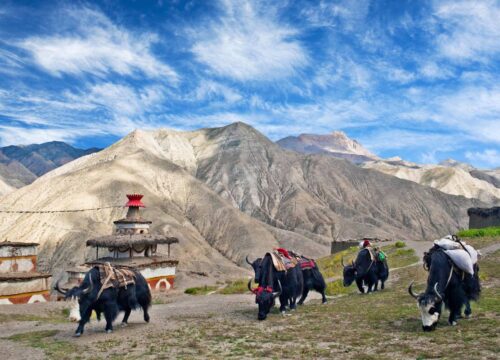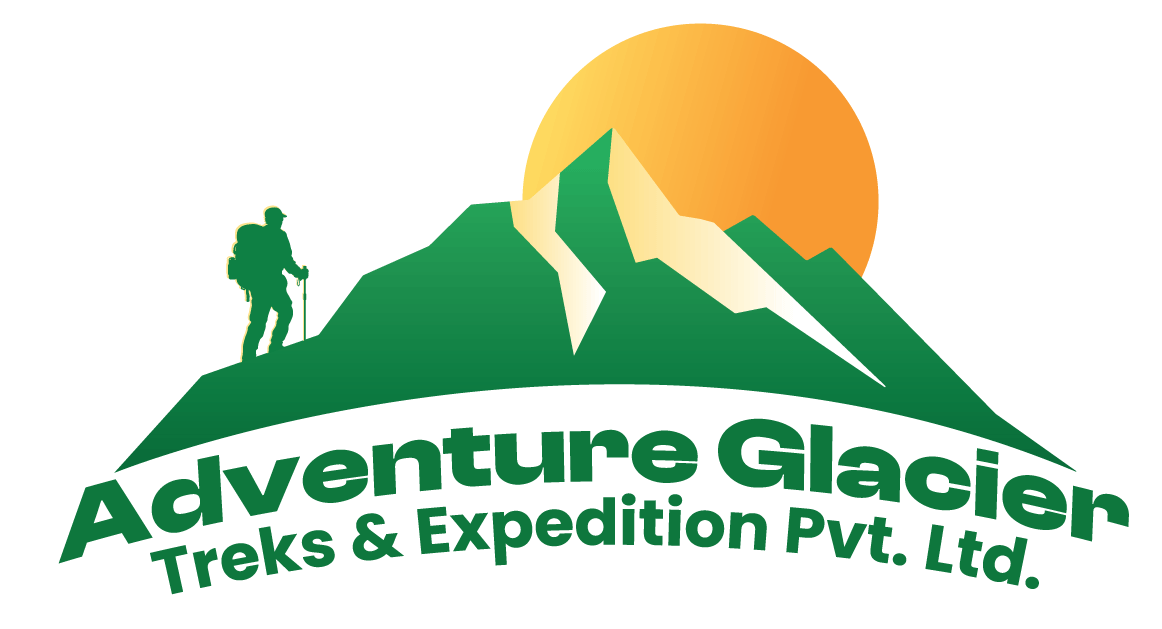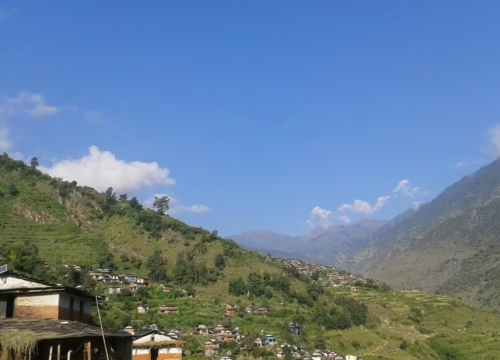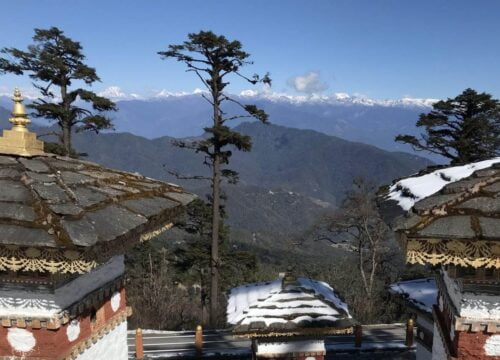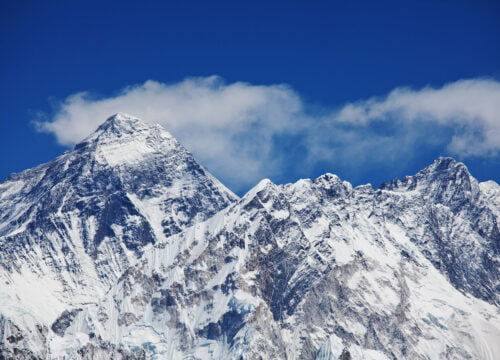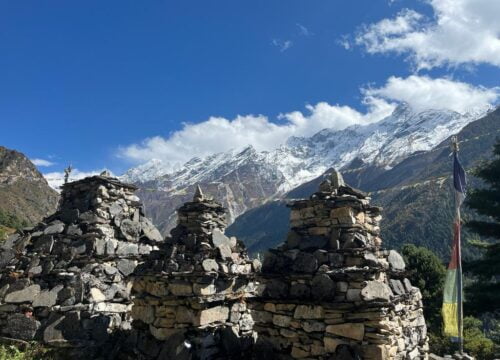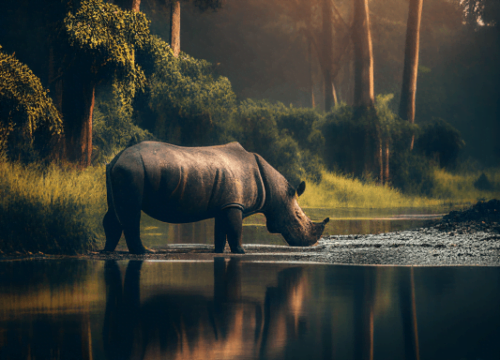Upper Dolpo Trek
Trip Overview
The Upper Dolpo Trek takes you to a remote and lovely place in western Nepal. It leads you to peaceful mountain villages, ancient monasteries, and impressive scenery that very few people get to visit. Anyone interested in discovering new spots and seeing another side of Nepal will love this 23-day trek.
The adventure starts by flying from Kathmandu to Nepalgunj and then to Juphal, the place where the trek begins. After that, you will explore quiet paths, cross tall mountain passes, and experience Phoksundo Lake, which is considered to be one of the most beautiful lakes in Nepal, as well as Shey Gompa, an old monastery in the center of Dolpo.
During your journey, you will notice snow-covered mountains, rugged cliffs, and large valleys. You will get to know residents who live normally and follow Tibetan Buddhism. The hike includes aspects of nature, culture, and adventure.
What Can You Expect From the Upper Dolpo Trek
The Upper Dolpo Trek gives you a chance to experience Nepal’s most secluded and unspoiled areas. You will leave the crowded tourist spots behind and travel into the mountains, where you will find calm nature and old Tibetan traditions.
- Breathtaking Nature: Go through high mountain passes, walk-in deep valleys, and enjoy the peace in quiet forests. You will get to admire the mountains with snow on top and the wonderful turquoise Phoksundo Lake.
- Unique Culture: You can find the people of Dolpo in small villages who practice Tibetan Buddhism. You will be able to visit monasteries such as Shey Gompa and find out how they live in harmony and simplicity.
- Peaceful Trails: Since the route is less famous, the Upper Dolpo trek is peaceful and not as crowded as other treks. Anyone who loves hiking in nature and wants to escape the city will enjoy it.
- Physical Challenge: This hike takes a lot of effort because it is long and includes many high-altitude sections. You need to be fit and able to walk a lot and camp in places that are far from civilization.
- Unforgettable Experience: Every day offers something special, like clear lakes, old shrines, amazing nature, and warm-hearted people.
Other Related Treks in the Upper Dolpo Region
If you want to discover more of the remote and wonderful Dolpo region, these are some related treks you might like.
- Lower Dolpo: A route that is shorter and a little simpler than the Upper Dolpo Trek. You will pass through beautiful valleys, visit typical villages, and see Phoksundo Lake, gaining both nature and cultural experiences.
- Shey Gompa Trek: The main goal of this trek is to get to the sacred Shey Gompa monastery. It’s an excellent choice if you wish to discover Dolpo’s spiritual side and admire the peaks around it.
- Dolpo to Jomsom Trek: A path that goes from Dolpo to the Mustang region and is more adventurous. It climbs high mountains and takes you through isolated areas, finishing in the windy town of Jomsom.
- Phoksundo Lake Trek: This hike is good for those who have only a short time. The journey takes you to Phoksundo Lake and nearby villages so you can experience Dolpo’s unique nature and culture.
Every one of these treks lets you enjoy the beauty and culture of Dolpo, as well as explore the region with fewer crowds.
Trip Itinerary
Your trip starts when you arrive at Tribhuvan International Airport (TIA), which is in Kathmandu, the capital of Nepal. When you arrive, a representative from Adventure Glacier Treks will be at the gate with a sign that has your name on it. After you arrive at the airport, you will be easily transferred to your hotel to rest and get comfortable. Once we’ve rested, we will give you a thorough overview of what to expect on your trek and climb. You will need to provide important details about the route, the altitude you plan to climb, how to stay safe and the permits needed for the expedition. If you arrive early or late, you can either visit the nearby areas, see the Pashupatinath or Boudhanath temples or relax after your flight. Starting your adventure in the remote areas of Upper Dolpo with Kathmandu’s colorful culture, history, and hospitable people is a great way to begin.
- Accommodation: Hotel in Kathmandu
This day, you are going to get information about how to prepare for the Upper Dolpo trek. During the morning, we will help you inspect your equipment to guarantee it is all set. If any equipment is lacking or not working, we will tell you if it should be bought, rented, or borrowed. When the check is done, you have the freedom to explore the lovely Kathmandu Valley. You may visit Swayambhunath (Monkey Temple), Pashupatinath Temple, or the squares of Kathmandu, Patan, and Bhaktapur. You can also choose a guided tour for an additional charge. This day is the ideal moment to get to know Nepal’s culture and history before you begin exploring the Himalayas.
- Accommodation: Hotel in Kathmandu
- Trek Duration: No trekking today
- Highlights: Gear check, cultural exploration of Kathmandu Valley, optional guided tours
On this day, you will fly for an hour from Kathmandu to Nepalgunj, an active town in western Nepal close to India. The town acts as the main gateway to reach remote places, including Dolpo, Humla, and Simikot. Because it is in the Terai region, Nepalgunj has a warm climate and blends Hindu, Muslim, and hill traditions, which makes it different from Kathmandu. Should you have extra time, you may visit the Mini Zoo, the Muslim Bazaar, or some of the nearby villages. You should use this time to check all your equipment and make certain you are ready for what lies ahead. Relax in the evening and prepare yourself for your trip to the Himalayas.
- Accommodation: Hotel in Nepalgunj
- Trek Duration: No trekking today
- Highlights: You will enjoy a flight to Nepalgunj, see the mix of cultures in the Terai area, and have options to explore (Mini Zoo, Muslim Bazaar, local villages).
In the early morning, you will fly for 35 minutes from Nepalgunj to Juphal in a Twin Otter plane, which is common in Nepal’s mountain areas. Most flights are punctual, but there is a chance for delays because of weather or technical reasons. After you land, you meet the whole trekking group, get our belongings ready, and start our hike. You will travel along the trail through terraced land, pass by small settlements, and walk close to the Bheri River in its narrow canyon. As you move forward, you will notice the scenery changing, revealing how rough the hiking trail will be. After three hours, you arrived at Dunai, which is the biggest village and the main headquarters of Dolpo. You will sleep in our tents near here and get ready for the next part of our adventure in the morning.
- Accommodation: Camping near Dunai
- Trek Duration: 3 hours / Distance: ~8 km
- Highlights: Scenic air trip to Juphal, hike through the terraced fields and narrow valley by the Bheri River, and reaching the district headquarters of Dolpo
After Dunai, use the new suspension bridge to cross and take the path west, then follow the Suli Gad River as it meets Thuri Bheri. The route is mostly uphill, but it is simple to walk on. The sound of the river will be close by all the time. On the journey, you will notice millet, pumpkins, potatoes, corn and chili fields and also wild marijuana plants. In addition, people from the area gather a plant called “chuk” to make vinegar and medicine. You will come across three villages with interesting names: Parela (eyelash), Rahagaon (eyebrow) and Ankhe (eye), which are close to the park’s entrance. After six hours, you will stop for the night in tents.
- Trek Duration: 6 hours / Distance: approx. 15 km
- Accommodation: Camping in tents near Ankhe
- Highlights: Enjoying the walk over a suspension bridge, along the banks of the Suli Gad and Thuri Bheri rivers, through fields of millet & potatoes, and wild plants, and visiting villages with interesting names (Parela, Rahagaon, Ankhe).
This day's hike is both fun and has many beautiful views. The first part of the trek is a crossing over two solid suspension bridges over the Suligad River. The section following is very narrow and goes up a cliff. Stay alert, but enjoy the wonderful views of the river and forest. The path goes down to the river for a brief rest from the climb. Then, the road gets steep, so you will want to stop a few times to rest and enjoy the scenery. The route goes through dense forests, and you can see some wild animals as you walk. At last, you get to Renje, a quiet place near the Suligad River. A challenging day can be made better by relaxing by the river and inhaling the fresh air from the mountains.
- Trek Duration: 7 hours / Distance: approx. 16 km
- Accommodation: Camping in tents near Renje
- Highlights: Things to enjoy: Walking on two solid bridges over the Suligad River, walking along the cliffside, seeing the forest and wild animals, hiking uphill, taking a break by the river
First, you walk along a flat path beside the river. When you get to Sumdo, the path starts to go uphill, and you leave the river below. Soon, you arrive at a ridge that is around 3,875 meters above sea level, and here you can see Phoksundo Lake and Nepal’s tallest waterfall, which is almost 300 meters tall. You won’t forget the fantastic view from this location. After a while, the trail takes you down a slope through peaceful and lovely birch forests. After that, you move along the upper part of the Phoksundo River. When you finish your peaceful walk, you arrive at the lovely village of Ringmo, which is near the lake. The village is decorated with mud-plastered chortens and mani walls, showing how much Tibetan Buddhism is present. Solar panels have made life better for people in the area. You will spend the night camping amidst mountains, nature, and the local culture.
- Trek Duration: 6.5 hours / Distance: approx. 14 km
- Accommodation: Camping in tents at Ringmo Village by Phoksundo Lake
- Highlights: You can enjoy the trail along the river, have fantastic views of Phoksundo Lake and Nepal’s top waterfall (300 m) from the ridge at 3,875 m, walk-in birch forests, and visit Ringmo to see chortens and mani walls.
You will walk by the edge of the beautiful Phoksundo Lake this day. Wooden walkways along the narrow trail are attached to the cliffs, proving that this region is still very remote and untouched. After the lake, the trail becomes very steep, leading up to 4,040 meters and giving views of the valley and the area. Traveling on this route is useful for escaping the strong winds usually found in the lower valley. At the beginning of the descent, the path passes through the Phoksundo Khola floodplain and gets smoother. You will then cross a peaceful forest and follow the river to your campsite. After an exciting day, you will settle in your tents by the river, under the trees and with the relaxing nature sounds around you.
- Trek Duration: 6 hours / Distance: approx. 13 km
- Accommodation: Camping by the river near Phoksundo Khola
- Highlights: Memorable moments: Enjoying the wooden trails near the cliffs, reaching the top at 4,040 m with amazing valley views, walking through the forest and by the river, and camping next to a river with nature’s sounds.
This day's trek involves creek crossings, so wear sandals or water-resistant footwear. The trail goes north through a valley filled with glaciers and impressive cliffs and rocks. As you continue, you get to a bridge over Phoksundo Khola, where it meets a mountain stream. At this point, it is hard to tell what to do next, and you need to step over rocks and cross a fast-flowing stream. The next part is a steep climb to a place called the “sheep valley” and then a rocky ravine. After a challenging ascent, you come to a valley that is not far from Kang La Pass. You will make camp just below the pass at the place Peter Matthiessen named “Snowfields Camp.”
- Trek Duration: 7 hours / Distance: approx. 15 km
- Accommodation: Camping at “Snowfields Camp” below Kang La Pass
- Highlights: Sandals or waterproof shoes are needed for creek crossings. The valley is full of glaciers, rocky ravines, and a steep climb through Sheep Valley, and it is close to Kang La Pass.
This day's trek is physically demanding, especially while climbing the loose slate trail up to Kang La Pass. It will take you around 2.5 to 3 hours to get to the top, but the beautiful views you see there are worth it. According to the map, the pass ranges from 5,200 m to 5,500 m. It takes around 45 minutes to go down the steep slope and reach the valley’s floor. After that, the trail stays near the river, crossing it only once. Eventually, you reach Shey Gompa through a red chorten and a small wooden bridge, as it is a peaceful and sacred place. Stay in a place that is near the monastery.
- Trek Duration: 7 hours / Distance: approx. 16 km
- Accommodation: Stay near Shey Gompa monastery (camp or basic lodge)
- Highlights: Points of interest: Tough ascent to Kang La Pass (2.5-3 hours), scenic views of the Himalayas from the pass (5,200–5,500 m), tough descent down to the valley, crossing a river, and stopping at the peaceful and sacred Shey Gompa with its red chorten and wooden bridge.
Shey Gompa is also called the Crystal Monastery because it is found near the holy Crystal Mountain. The word “Shey” refers to the crystal, and the nearby mountain is known for its special twisted cliffs full of quartz and marine fossils. Usually, the lama of Shey lives at Tsakang Gompa, a red retreat that is used by many Tibetan lamas for meditation. Shey is a monastery of the Chaiba community, belonging to the Kagyu and Padmasambhava traditions, and was the first Kagyupa monastery started by lama Tenzin Ra-Pa in the 11th century. Drutup Yeshe brought Buddhism to Dolpo by meeting mountain-worshipping tribes and helping them accept the new beliefs. The town of Shey Gompa is positioned at the meeting of the Yeju and Kangjun rivers, and there, you can see water-powered prayer wheels turning calmly. A rest day in Mecca offers a wonderful experience of culture and religion. Stay in a camp close to the monastery.
- Trek Duration: Rest day
- Accommodation: Camp near Shey Gompa monastery
- Highlights: Crystal Monastery is worth a visit; you can also explore Kagyu and Padmasambhava traditions, watch water-powered prayer wheels, and enjoy an experience of both culture and spirituality
The hike starts with a gentle walk among juniper trees into a grey canyon. When the weather is nice, you will head for a flat open space to have lunch or take a short break. After a tough 20-minute climb, you will arrive at the Saldang La Pass, which gives you a chance to see the snow-covered Tibetan peaks and the dry Mustang region. You will then start a lengthy descent, which takes us north into yak pastures, where animals are quietly grazing. You arrive at Namgung, a place where there is a red monastery belonging to the Karma-pa sect, just like Shey Gompa. Surrounded by the cliffs, the monastery and its white stupas add bright color to the area. The village of Namgung has only six stone houses and terraced fields on both sides of a stream. People in the area mainly depend on farming, raising livestock, and trading, and they grow barley, buckwheat, potatoes, radishes, and oilseeds. Stay the night in a tented camp close to the village.
- Trek Duration: 7 hours / Distance: approx. 15 km
Accommodation: Camping near Namduna village - Highlights: Walking through juniper forests, eating lunch in open areas with mountain views, climbing the Saldang La Pass, great views of Tibetan peaks and Mustang, trekking down to yak pastures, visiting the red monastery of the Karma-pa sect, and seeing terraced fields in Namduna.
You will start early by ascending from Namgung Monastery into a dry and rough area. The path continues, and as you descend, you see a green valley with terraces and crops, proving how local farmers make the most of the land. Once you reach the top, you go down steep slopes to get to the beautiful village of Saldang. Saldang sits higher than the Nam Khong Nala, making it the biggest village in the Inner Dolpo region. Unlike Ringmo, which is surrounded by trees, Saldang is in a dry, mountain desert above the Himalayas. The village stretches about 2 kilometers and includes five small villages, over 80 stone houses, and around 600 people. Being a farming area and being situated on a well-known trade route to Tibet are the reasons for its prosperity. You will spend the night in this special village that is rich in culture.
- Trek Duration: 4 hours / Distance: approx. 10 km
- Accommodation: Stay in local guesthouse or tent camp in Saldang village
- Highlights: You will hike up and down through dry rocky areas, see a green terraced valley, reach the largest village in Inner Dolpo, experience the rich culture, and visit a place where farming and trading take place.
Leaving Saldang, the trail descends through terraced fields, ancient stupas, chortens, Mani stone piles, and a Chaiba monastery. After that, you come to Namdo, a prosperous village where about 400 people live in 60 houses along the Nam Khong Khola, covering 5 km. The river finds the Namdo monastery, and another is found on top of a cliff. After exploring the river, you get to Sibu and pitch your tent by the river’s edge. Because it is so peaceful, it’s a great place to relax.
- Trek Duration: 6 hours / Distance: approx. 14 km
- Accommodation: Tented camp by river at Sibu
- Highlights: Go down through the terraced fields, see old stupas, walk past mani stones, visit Chaiba monastery, explore Namdo village and monasteries, and camp by the river.
At the beginning, the trail is mellow as it follows the river for two hours. Crossing the second stream, the trail goes into a side valley and climbs uphill. The place is a rough but beautiful meadow with boulders, yaks, and signs left by animals. At this point, you will camp out and get ready for the climb to Jeng La the next day. You will stay overnight in a tented camp.
- Trek Duration: 5 hours / Distance: approx. 12 km
- Accommodation: Tented camp in a meadow near the base of Jeng La
- Highlights: The highlights are a walk by the river, a short climb in a side valley, seeing yak herds, a peaceful alpine meadow with signs of wildlife, and getting ready for the next day’s pass.
The hiking journey starts on a path that is steep but firm, so it is not difficult to get to Jeng La Pass in two hours. The top offers a wonderful view of the Dhaulagiri range, which looks especially bright in the morning. A rocky trail takes you down to the beautiful Tarap Valley. Later in the day, the path goes through a green area by the Tarap Chu River. The valley has a length of 20 km, with meadows, tall mountains, old monasteries, and ten traditional villages. You will see Buddhist and Bonpo chortens, which represent the strong spiritual background of the place. Tent near Tokyu Gaon and appreciate the calm of the natural surroundings.
- Trek Duration: 7 hours / Distance: approx. 16 km
- Accommodation: Tented camp near Tokyu Gaon
- Highlights: The climb to Jeng La Pass is not easy but doable; the view of the Dhaulagiri range at sunrise is spectacular, the valley below is filled with Buddhist and Bonpo chortens, and the area is full of green valleys and rivers.
After a short visit to Chaiba Gompa, head on to Dho Tarap; the track is broad and often used, going past fields where women collect crops and men lead livestock to keep them safe during the winter. On your journey, you will notice the traditional Mani walls and several weathered chortens. Near the village you will find the "French School." Most of the people living in Dho Tarap are Magars, while there are some Tibetans as well. Somba locals usually wear their traditional leather boots and often have coral, turquoise, and religious amulets. People in the village follow both the Bon Po and the Nyingmapa traditions of Buddhism. A short walk takes you to the Buddhist Gompa and the Bon Gompa.
- Trek Duration: 4.5 hours / Distance: approx. 11 km
- Accommodation: Tented camp in Dho Tarap village
- Highlights: Some of the main things to see are Chaiba Gompa, fields with crops, stone Mani walls, different types of chortens, and local Magar and Tibetan people in their colorful dresses.
The trail goes down along the Tarap Khola through narrow canyons where the water is fast-moving. While traveling, you may run into Dolpo locals moving their sheep and goats to lower areas for the winter season, and you could also see blue sheep, marmots, yaks, and other animals. In the afternoon, the path leaves the river and gets more wavy. You will come across a modern bridge made of steel that both people and animals can use. At some points, the trail will be crowded. You will camp for the night on a grassy spot beside the river.
- Trek Duration: 6.5 hours / Distance: approx. 16 km
- Accommodation: Tented camp beside the Tarap Khola
- Highlights: The trip includes going through narrow gorges alongside the Tarap Khola, seeing blue sheep and locals, using a modern steel bridge, and camping by the river beside impressive canyon walls.
The trek continues this day by going through the Tarap River canyon, sticking to a narrow path that is sometimes near the river and, at other times, far above it. The trail is sometimes wide and steady, but it can also be very narrow and unstable, so you need to watch your steps carefully on the man-made stairs. The day brings exciting views of the gorges and their amazing depths. Once you finish the challenging part, you arrive in a peaceful meadow under trees, where you will pitch your tents for the night.
- Trek Duration: 7 hours / Distance: approx. 18 km
- Accommodation: Tented camp in a wooded meadow
- Highlights: Hiking a high route in the canyons, crossing narrow and exposed paths, walking on stone stairs, and finishing the hike in a peaceful forest glade.
After crossing a new suspension bridge, the trail follows the river closely and sometimes climbs above it. Since one of the old bridges hasn’t been used for six years, you will need to carefully step on wet stones to cross a stream. The path then leads into the Barbung Chu Valley, where you will walk through fields of millet, barley, corn, buckwheat, beans, chilies, and even some wild marijuana. Lunch gets served near a water tap, and your campsite will be set up a little farther from the river. Before the Gorkha dynasty, Tarakot was the capital of the region and known as a Dzong, meaning a fortified place. Trade in the area was once controlled by Sandul Gompa, an old monastery located about 8 km east of town. You will spend the night in a tented camp.
- Trek Duration: 4 hours / Distance: approx. 10 km
- Accommodation: Tented camp near the river close to Tarakot
- Highlights: Crossing the suspension bridge, hopping on stones across the streams, walking through the farmland of Barbung Chu Valley, and finding out about Tarakot’s past as a Dzong.
The path this day is mostly on a downhill slope and is well looked after. You will be able to see the river from a path that is built about 20 feet above its surface. After a nice and calm walk, you will arrive at Dunai, the main town in Dolpa, where your trip to the Dolpo region finishes. After this, you can celebrate with your team because your adventure is now complete. Sleep in a tent tonight.
- Trek Duration: 5 hours / Distance: approx. 13 km
- Accommodation: Tented camp in Dunai town
- Highlights: Enjoy a simple walk downhill, admiring the beautiful river gorge, and getting to the main town of Dolpo to mark the end of the trip.
This day is your last trekking day as you go back to Juphal along the same path. You start by walking along the river at an easy pace, but the last hour consists of a steady climb that could feel harder than it seemed at the start. When you get to Juphal, you end a memorable journey through the beautiful and remote Dolpo area. Sleep in a tent camp at night.
- Trek Duration: 3 hours / Distance: approx. 8 km
- Accommodation: Tented camp in Juphal
- Highlights: You will start by walking by the river, then climb steadily to reach remote Dolpo, and finish the trek back to where you started.
Start the day with an early morning flight from Juphal to Nepalgunj. During this 35-minute flight, you get to see the Himalayan foothills and important peaks like Annapurna and Dhaulagiri from above. From Nepalgunj, you go on a connecting flight to Kathmandu. When you get to your destination, check into your hotel and have a good night’s rest.
- Flight Duration: 35 min (Juphal–Nepalgunj) + 1 hour (Nepalgunj–Kathmandu)
- Accommodation: Hotel in Kathmandu
- Highlights: Getting to see the Himalayan peaks, returning to the city, and resting after your mountain adventure.
Note: During high season, if 3-star hotels are fully booked, we will provide similar accommodations that meet tourist-standard hygiene and service levels.
FAQs
Are there any health checks during the trek?
Yes, our guides do frequent informal health checks, particularly at higher altitudes. They watch out for symptoms of altitude sickness, check your energy levels, and inquire about how you feel to identify any problems early enough and make changes in case of necessity.
How to prepare for high-altitude glacier trekking?
Hike regularly to increase your stamina and get used to walking in hills for a long time. Ensure you are prepared to avoid altitude sickness while you are on your trek.
What gear do I need for a glacier trek?
Warm clothes, trekking boots, gloves, sleeping bag, down jacket, sunglasses, sunscreen, trekking poles, and a first aid kit. A headlamp and water bottle or filter are also helpful.
Do I need a guide or porter for a glacier trek?
It is strongly advised to have one. A guide ensures you don’t get lost and remain safe. You can ask the porter to help you with your heavy bag.
Where is Upper Dolpo, and why is it special?
The area of Upper Dolpo is in the northwest region of Nepal, not far from the border with Tibet. What makes it unique are its remote location, Tibetan customs, and the beautiful Phoksundo Lake.
How long does the Upper Dolpo Trek take?
The Upper Dolpo Trek usually takes about 23 days, including travel and time to adjust to the high altitude. This allows trekkers to explore the region safely and enjoy its remote beauty.
Can the Upper Dolpo Trek be done independently?
It is not possible to trek in the Upper Dolpo area alone. You are required to go with a registered guide and in a group of at least two people since the area is restricted.
What are the highlights of the Upper Dolpo Trek?
The Upper Dolpo Trek offers a chance to see the beautiful Phoksundo Lake, the old Shey Gompa monastery, the Himalayas, remote mountain villages, and Tibetan culture.
Is the Upper Dolpo Trek worth it?
Yes, it is a special trip with amazingly untouched scenery, peaceful paths to follow, and a rich culture to explore. The amazing scenery and spiritual feeling make it an experience I will never forget.
What permits are required for the Upper Dolpo Trek?
You have to apply for the Upper Dolpo Restricted Area Permit and the Shey Phoksundo National Park Permit. It is required by law to arrange both through a registered trekking agency.
What is the best time to trek in Upper Dolpo?
May to October are the ideal months because it is dry and the sky is usually clear. These seasons have clearer skies and safer paths for hiking.
What is the accommodation like in Upper Dolpo?
Camping in tents is common at night because the area is very far from towns. Some villages have simple lodges or homestays that you can use.
What is the food like on the Upper Dolpo Trek?
Dal Bhat (rice and lentils), noodles, soups, and tea are the main parts of most meals. The team in charge of trekking usually prepares the food while walking.
Can I bring my water purification tablets or filters?
Yes, bringing your water purifier or tablets is highly recommended. It helps make a stream or tap water safe to drink during the trek.
Book Now
Price Includes
- Airport Pick up/drop
- Accommodation in kathmandu
- All inclusive trek such as Ground transportation, necessary permits ( including special permit), entrance fess, professional guide, porter/porters, and their expenses including their insurance and equipments
- Accommodation in the tent ( Mattress, sleeping bags) or at guest houses/home stays
- Three meals a day (breakfast, lunch & dinner) with cup of tea/coffee
- All domestic flights
Price Excludes
- Alcoholic drink
- Tips
- Your insurance
- Personal/natural expenses
- Food in Kathmandu
